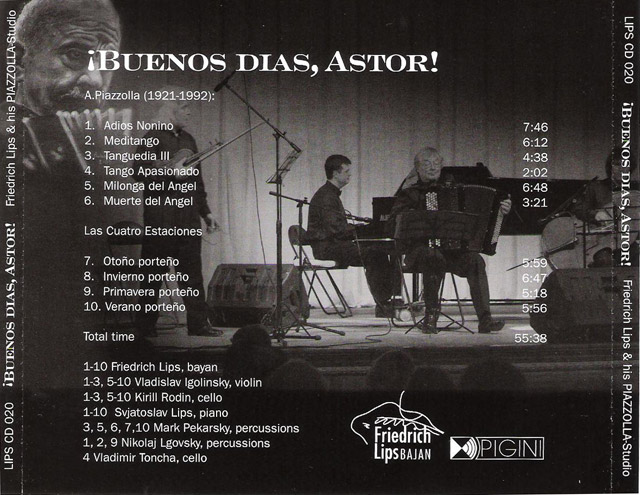|

¡BUENOS DIAS, ASTOR!
Once again, the Russian bayanist, Friedrich Lips, has given the
music world something more to admire. The ten pieces heard on
this CD are performed with the unerring expertise expected of
this group of musicians. They play with perception, sensitivity
and style throughout this outstanding collection of Piazzolla
masterpieces.
The first six
pieces, all by Astor Piazzolla (1921-1992), represent some of
his most popular compositions. All of them have been recorded
multiple times by multiple groups. The members of the Friedrich
Lips & his PIAZZOLLA-Studio not only may be added to these
numbers but they also contribute significantly important performances
of the repertoire.
Adiós
Nonino is perhaps Piazzolla's single most famous piece of his
many compositions. While Nonino was written as a pleasant, chirpy
tango from Piazzolla's days in Paris and in honor of his father,
Vicente, it evolved into its present form Adiós Nonino
after the death of his cherished father. Piazzolla, in 1980, said:
"Perhaps I was surrounded by angels. I was able to write
the finest tune I have written. I don't know if I shall ever do
better. I doubt it." He played it thousands of times, in
at least twenty different arrangements. While the symbolism and
the pure beauty of it are indeed special, the next five pieces
are no less important, however, and represent some of his best
repertoire. Both Milonga del ángel and Muerte del ángel
will draw your immediate admiration as will Meditango, Tanguedia
III and Tango apasionado. Tango apasionado is part of Piazzolla's
The Rough Dancer and The Cyclical Night and he said, "It's
music to be played by half-drunk musicians in a bordello."
The CD closes
with the four pieces, Otoño (Autumn) porteño (1969),
Invierno(Winter) porteño(1970), Primavera (Spring) porteña
(1970), and Verano (Summer) porteño (1964), which comprise
the tango cycle known as Las Cuatro Estaciones or The Four 'Buenos
Aires' Seasons. (A porteño is an inhabitant of the city
of Buenos Aires, therefore, the name of the city is often included
in the title.) Although not written as an homage to Antonio Vivaldi
(c. 1678-1741) and his The Four Seasons (Le quattro stagioni),
the two compositions are often compared. Le quattro stagioni was
part of Vivaldi's Opus 8 appearing in 1725, representing four
concertos of his 500 concertos. Piazzolla's four compositions
were not even originally intended as a single suite, but were
at times performed in that manner by Piazzolla. As a matter of
fact, other pieces related by titles, such as Milonga del ángel
and Muerte del ángel, for example, were also played as
a single suite at various times.
Vivaldi earned
a reputation as a violinist of great energy and daring with the
sheer vitality of his work inspiring soloists to perform dazzling
displays of virtuosity. In this respect, Piazzolla also displayed
this same raw energy, while garnering a reputation as both composer
and virtuoso performer on the bandonéon. Certainly, Vivaldi's
The Four Seasons is an early example of program music, where the
music tells a story or depicts a scene, and Piazzolla's four pieces
comprising this tango cycle could likewise compare, although Piazzolla
made no effort to do this. Piazzolla often opened with Autumn,
however, while Vivaldi began with Spring when played together.
Both composers featured individual players as soloists in a concerto
style. The Otoño, for example, has one of the most amazing
solos for the bandonéon left hand!
Piazzolla's four
pieces offer an ideal introduction to the unique tango-classical
styles created by the Argentine master. There are furious unison
passages contrasting with stretches of moody quiet. The pieces
are always exciting; they are never dull. The purposeful rubato,
the often harsh and edgy accents, the sometimes impatience of
the music - glide into a never-cloying sweetness and back again.
Listen to the tango-fugue in Primavera!
The term virtuoso
describes both the repertoire and the musicians listed above.
While many know and admire the serious classical work of Friedrich
Lips, perhaps even more will do so as a result of his recordings
of the Piazzolla tangos. It is not often that an artist with the
stature of Lips can be expected to perform both genres so favorably,
and yet, he does! The sumptuous phrasing, technical clarity, impeccable
bellows control, and yes, even those small but beautifully executed
grace notes, attest to the significance of his professional expertise,
whether it be the music of Gubaidulina or Piazzolla.
You will like
this CD; it is one you will return to time and time again. It
is completely enjoyable and absolutely superb from beginning to
end. If you like great musical performances and you also like
the music of Piazzolla, you should add it to your library now.
(Lips CD 020)
*
Reviewed by Joan
Cochran Sommers, November, 2008.
CD is available online, secure credit card server, and you can
hear sound samples:
http://www.musicforaccordion.com/Boutique/inform/lips/CD020.htm
|

